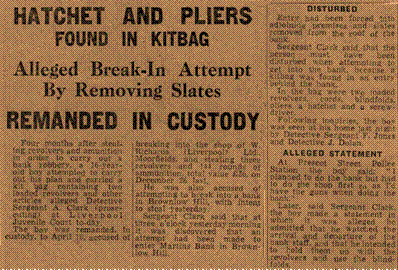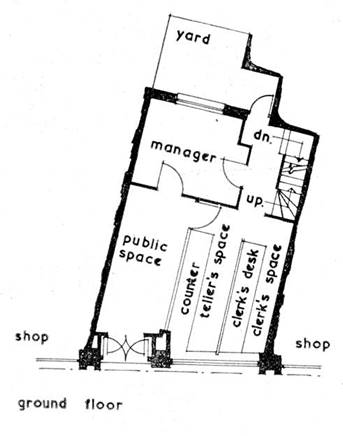|
|

|
This selection is from
Martins Bank’s 1961 Student Advertising Campaign a series of images that can
be used again and again.
Consequently, the faces of
these “students” will become quite familiar as they advertise the Bank’s
university Branches up and down the Country. Further down the page you can
read an article from the Architect and Building News from 1959 which reveals
some surprising facts about the conversion of this former shop into an outlet
designed to attract custom from Liverpool’s Students; but first – the fact
that Martins pioneers Liverpool University Branch at all is actually down to
the idea of a member of the Bank’s staff and in the following article from
Martins Bank Magazine’s visit to Brownlow Hill, we learn that the Assistant
Manager Mr W T Green is the man with the brainwave. The Branch is managed by
Mr Ken Tarbuck, who, not content with simply working for the Bank, is also a
successful rock climber who has invented a knot for the use and protection of
his fellow climbers! Still used today,
it bears his name – “The Tarbuck Knot”.
Having an ideas man – Mr Green, AND what amounts to a
“boy’s own hero” – Mr Tarbuck, on the premises might be a definite advantage
for a Bank aiming to attract the financial business of those “go-getting”
graduates of tomorrow… |
In service: Thursday
1 May 1958 until 1966 then moved (see foot of page)
|
||||||||||||||||||||||||||||||||||
|
Image © Martins Bank Archive Collections (Restored and re-mastered 2018) |
Image © Martins Bank Archive Collections (Restored and re-mastered 2018) |
||||||||||||||||||||||||||||||||||
|
At any rate, the man whose idea it was has been given the
opportunity of helping to see his idea through to ultimate success by being
transferred to the new branch. W. T. Green is the name. The choice of manager for a branch such as this also
needed some very careful selection, and in Mr. A. K. Tarbuck a singularly
happy choice was made. Apart from a brief spell at Oxford branch all his
service has been performed at branches in the Liverpool district, latterly at
Heywoods branch. As a mountaineer and a
first-class rock climber, inventor of the Tarbuck knot used in climbing, and
the author of articles on mountain technique, Ken Tarbuck is well known to
the more adventurous types found, though not exclusively, in University
circles. His gay, sunny and friendly disposition and his frank and
sympathetic outlook on life, especially on youth and its problems,
particularly fit him to make a success of this branch. We are all watching
his efforts with keen interest.
|
|||||||||||||||||||||||||||||||||||
|
An early raid… We were
delighted to be contacted by Fiona Winter - the daughter of William T Green -
who shared with us a collection of letters and other items which illustrate
her father’s career with Martins Bank. On our STUDENT BANKING page, you will find a series of letters which chart
the inception and progression of Mr Green’s idea to bring student banking to
the University. No-one could have guessed how successful this idea would
become amongst the high street banks of the UK over more than forty years,
and this is a legacy of which Mr Green and his family were rightly
proud. The new University Branch had
been open less than a year before it was the subject of a planned bank raid. What makes this attemped robbery all the
more curious, is that the perpetrator was a sixteen year old boy. Among
Fiona’s father’s papers is the following cutting from the Liverpool Echo and
Evening Express from 3 April 1959. As
this item is showing its age, we have reproduced the wording alongside an
image of the cutting itself…
|
|||||||||||||||||||||||||||||||||||
|
Four months after stealing revolvers and
amunition in order to carry out a bank robbery, a 16-year-old boy attempted
to carry out his plan and carried a kit bag containing two loaded revolvers
and other articles alleged Detective Sergeant A Clerk (prosecuting) at
Liverpool Juvenile Court to-day. The Boy was remanded in custody, to April
10, accused of breaking into the shop of W Richards (Liverpool) Ltd.,
Moorfields, and stealing three revolvers and amunition total value £36, on
December 26 last. He was also accused
of attempting to break into a Bank in Brownlow Hill with intent to steal
yesterday. Sergeant Clerk said that at
three o’clock yesterday morning it was discovered that an attempt had been
made to enter Martins Bank in Brownlow Hill. Entry had been forced into
adjoining premises and slates removed from the roof of the bank. Sergeant Clerk said that the person must
have been disturbed when attempting to get into the bank, because a kitbag
was found in an entry behind the bank.
|
|
||||||||||||||||||||||||||||||||||
|
In the bag were two loaded revolvers, cords,
blindfolds, pliers, a hatchet and a screwdriver. Following inquiries, the boy was seen at
his home last night by Detective Sergeant F Jones and Detective J Dolan. At Prescot Street Police Station the boy
said: “I planned to do the bank, but had to do the shop first so as I’d have
the guns when doing the bank”. Later,
said Sergeant clerk, the boy made a statement in which he admitted that he
watched the arrival and departure of the bank staff and that he intended to
hold them up with the revolvers and use the blindfolds.
Fiona recalls her father
talking about the attempted raid, and how he and the Branch Manager Ken
Tarbuck actually climbed onto the roof of the Bank to try and replace the
disturbed slates – they were questioned by a passing policeman, who thought ANOTHER break-in was under way!
|
|||||||||||||||||||||||||||||||||||
|
On 9 December 1959, the Architect
and Building News publishes a feature focussing on the conversion of the
former “Squaredeals” shop at 164 Brownlow Hill within the precincts of
Liverpool university into a Branch of Martins Bank. As was mentioned in the
above article from Martins Bank Magazine, the Architect and Premises
Department really do “contrive a gem from somewhat unpromising material”. When compared to the lavish
builds, rebuilds and fitting out of many of the Bank’s new Branches in the
1950s and 60s, Liverpool University is definitely something of a poor
relation. Cheap materials abound and corners are cut, at what is originally
intended to be temporary premises, but which are in use for EIGHT years
before this part of the University is re-developed. Despite this, the overall
look is very good which belies the practical and economic approach of this
utility Branch.
|
|||||||||||||||||||||||||||||||||||
|
|
|||||||||||||||||||||||||||||||||||
|
The Banking Hall and Manager’s Office beyond |
Design
The clients wished to form a new
temporary branch with its architectural treatment having the maximum appeal
to university students who would be its main clientele.
It is a temporary branch with an
anticipated life of, say, five to ten years; this allowed a more uninhibited approach
than is usual in bank design, and determined the maximum use of inexpensive,
non-permanent materials.
Gay, colourful atmosphere was required
so that the premises would be inviting and less formal and awe-inspiring than
the more usual stolid character of most branch banks. |
||||||||||||||||||||||||||||||||||
|
Extremely
limited space determined maximum lightness of form, the least amount of
visual restriction and the careful selection and positioning of materials to
give directional emphasis to increase the apparent size of the bank, e.g.,
floor to ceiling mirrors at end of counter to "double" its length,
corrugating the counter front to give increased surface area, slotted
ceiling, diaper-patterned ceiling lighting, etc., marked colour contrasts
avoided in internal decorations.
|
|||||||||||||||||||||||||||||||||||
|
|||||||||||||||||||||||||||||||||||
|
Accommodation The
accommodation provided includes the banking hall and manager's room on the ground
floor, staff room and toilets on the first floor and storage space on the
second floor.
Construction The premises are very old and, although
in a dilapidated condition, had only minor structural defects. Replacement of
the existing shop by the new frontage to the ground floor involved no major
alterations to the structure. A limited contract period of only a few weeks,
and the deplorable condition of existing building with uneven walls and ceilings,
determined that inside finishes should be of dry construction, and therefore
walls and ceilings were battened out and faced with wall boards, faced with
small-scale pattern washable plastics sheeting. All joinery —except
counter top—is in painted softwood for economy.
|
Behind the counter - The Clerks
and Tellers’ spaces |
||||||||||||||||||||||||||||||||||
|
Images © Architect and Building News and successors - 9
December 1959 to date |
|||||||||||||||||||||||||||||||||||
|
|
|||||||||||||||||||||||||||||||||||
|
|
|||||||||||||||||||||||||||||||||||






















